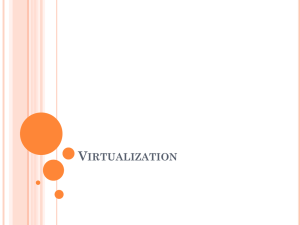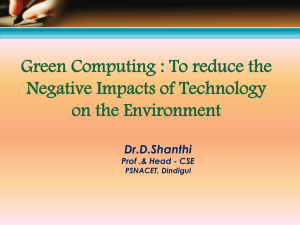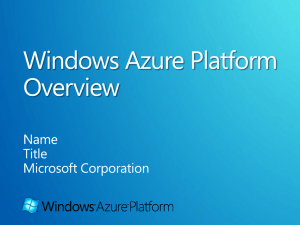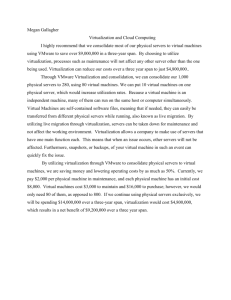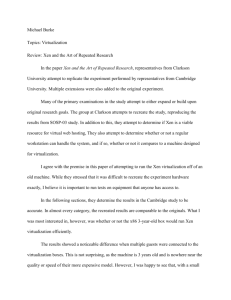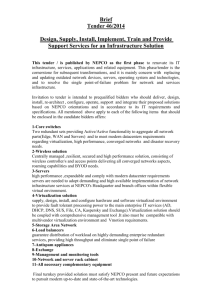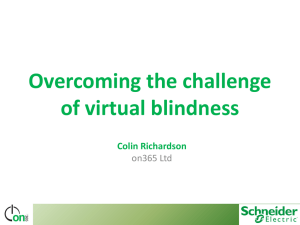green computing
advertisement
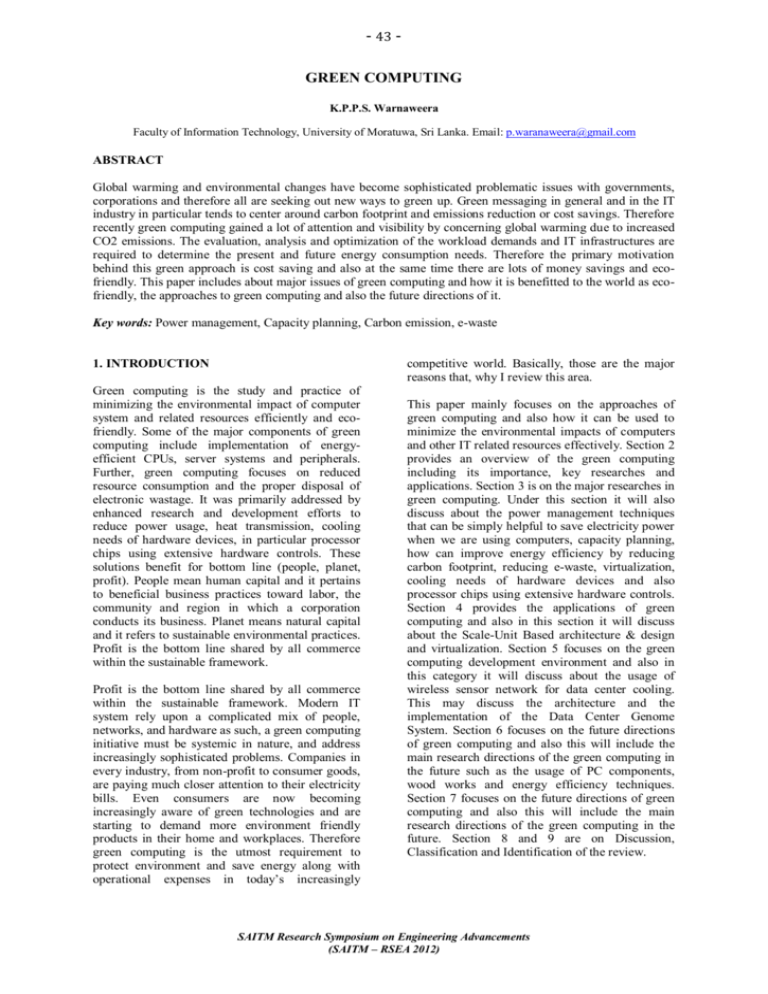
- 43 GREEN COMPUTING K.P.P.S. Warnaweera Faculty of Information Technology, University of Moratuwa, Sri Lanka. Email: p.waranaweera@gmail.com ABSTRACT Global warming and environmental changes have become sophisticated problematic issues with governments, corporations and therefore all are seeking out new ways to green up. Green messaging in general and in the IT industry in particular tends to center around carbon footprint and emissions reduction or cost savings. Therefore recently green computing gained a lot of attention and visibility by concerning global warming due to increased CO2 emissions. The evaluation, analysis and optimization of the workload demands and IT infrastructures are required to determine the present and future energy consumption needs. Therefore the primary motivation behind this green approach is cost saving and also at the same time there are lots of money savings and ecofriendly. This paper includes about major issues of green computing and how it is benefitted to the world as ecofriendly, the approaches to green computing and also the future directions of it. Key words: Power management, Capacity planning, Carbon emission, e-waste competitive world. Basically, those are the major reasons that, why I review this area. 1. INTRODUCTION Green computing is the study and practice of minimizing the environmental impact of computer system and related resources efficiently and ecofriendly. Some of the major components of green computing include implementation of energyefficient CPUs, server systems and peripherals. Further, green computing focuses on reduced resource consumption and the proper disposal of electronic wastage. It was primarily addressed by enhanced research and development efforts to reduce power usage, heat transmission, cooling needs of hardware devices, in particular processor chips using extensive hardware controls. These solutions benefit for bottom line (people, planet, profit). People mean human capital and it pertains to beneficial business practices toward labor, the community and region in which a corporation conducts its business. Planet means natural capital and it refers to sustainable environmental practices. Profit is the bottom line shared by all commerce within the sustainable framework. Profit is the bottom line shared by all commerce within the sustainable framework. Modern IT system rely upon a complicated mix of people, networks, and hardware as such, a green computing initiative must be systemic in nature, and address increasingly sophisticated problems. Companies in every industry, from non-profit to consumer goods, are paying much closer attention to their electricity bills. Even consumers are now becoming increasingly aware of green technologies and are starting to demand more environment friendly products in their home and workplaces. Therefore green computing is the utmost requirement to protect environment and save energy along with operational expenses in today’s increasingly This paper mainly focuses on the approaches of green computing and also how it can be used to minimize the environmental impacts of computers and other IT related resources effectively. Section 2 provides an overview of the green computing including its importance, key researches and applications. Section 3 is on the major researches in green computing. Under this section it will also discuss about the power management techniques that can be simply helpful to save electricity power when we are using computers, capacity planning, how can improve energy efficiency by reducing carbon footprint, reducing e-waste, virtualization, cooling needs of hardware devices and also processor chips using extensive hardware controls. Section 4 provides the applications of green computing and also in this section it will discuss about the Scale-Unit Based architecture & design and virtualization. Section 5 focuses on the green computing development environment and also in this category it will discuss about the usage of wireless sensor network for data center cooling. This may discuss the architecture and the implementation of the Data Center Genome System. Section 6 focuses on the future directions of green computing and also this will include the main research directions of the green computing in the future such as the usage of PC components, wood works and energy efficiency techniques. Section 7 focuses on the future directions of green computing and also this will include the main research directions of the green computing in the future. Section 8 and 9 are on Discussion, Classification and Identification of the review. SAITM Research Symposium on Engineering Advancements (SAITM – RSEA 2012) - 44 2. OVERVIEW OF GREEN COMPUTING In this present globalized world, with the development of Information Technology, not just at home but also virtually every commercial organizations of any size is heavily reliant upon IT. Even though, this provides numerous good impacts, power consumption related to technology is rising rapidly. At home there is a little we can do regarding our use of IT, other than not leaving our PC’s switched on unnecessarily, but for organizations there is massive scope for affecting energy use, recycling and profit through adopting a green approach to IT. As mentioned before, nowadays the power consumption related to technology is rising rapidly according to the rapid development of Information Technology. The recent U.S. Environmental Protection Agency (EPA) [1] report says that the IT industry consumed approximately 61 billion kilowatt-hours of electricity in 2006. That’s 1.5 percent of the total electricity consumed in the United States. At the same time, servers and data centers deployed by the U.S. Federal Government account for about 10 percent, or 6 billion kWh, of the total consumption. Also, the EPA report estimated that IT power consumption could nearly double by 2011[2]. Therefore IT management has to understand the basic concepts of green computing and how the investments can be improved through this approach. There are plenty of ways to be green and also in the IT world, the solution falls into three general categories; Improve energy efficiency by reducing carbon footprint. Reduce e-waste[3] Enable lifestyle changes that lower impact on the environment There are some green computer strategies that can reduce carbon emissions such as using virtualization to reduce number of servers, using virtualization to reduce power and disposal requirements of desktops, replacing paper systems with on-line communication systems and etc. Virtualization can be used to carve up a single physical machine into number of virtual servers. So each virtual server can operate with the same independence from each other with most virtual software techniques. As it is mentioned before, by reducing the amount of material wastage in manufactured products and using more recyclable materials, manufacturers are reducing negative environmental impacts. Those key researches will be further discussed under section 3. 3. MAJOR RESEARCHES IN GREEN COMPUTING Technology is understood to have a complex relationship with environmental issues. While traditional environmentalism argued for a reduction in technology, more recent environmental perspectives tend to recognize positive opportunities for simultaneous advances in environmental responsibility, quality of life, and economic growth. Accordingly, while computing technology can be viewed as “part of the problem” via issues such as e-waste and energy consumption, computing technology can simultaneously be viewed as “part of the solution” by enabling better use of resources in a wide range of domains. In order to minimize the environmental impacts of computers and other IT related resources effectively, green computing is the best solution. There are different kinds of power management techniques when we are using computers. As well as we have to consider about capacity planning, carbon footprint reducing, reducing e-waste and cooling needs of hardware devices and also processor chips using extensive hardware controls. 3.1. Power management techniques When considering the conserving of energy, the computers can be activated in “Stand-by” mode when it is not in use and therefore it can be reduced the energy consumption by 80%. On the other hand the “hibernate” or “deep sleep” mode can reduce the energy consumption by 96% as offering greater savings [4]. Do you know the desktop computer uses six times more energy than laptop as much as 80% less? When we consider about monitors, large Cathode Ray Tube (CRT) monitors and high resolution models use more energy than small ones. The Liquid Crystal Displays (LCDs) which are used in laptop computers are more energy efficient and also the use 10% - 20% of power. By identifying the power management techniques as more, it can be categorized some tips which are helpful to conserve energy when we are accessing computers. Turn off the computer when you are finished. Set the shortest possible time that is acceptable before the computer automatically powers down. Turn off the monitor whenever you will be away from the computer. Do not turn on the printer until you are ready to print. Enable energy management setting on the computer. 3.2. Capacity planning Capacity planning is a process that is being used to manage the IT resources. Independent research studies conducted by IDG [5] and Hewlett-Packard SAITM Research Symposium on Engineering Advancements (SAITM – RSEA 2012) - 45 (HP) [6] in 2006 revealed that 50 cents is spent on energy related expenses for every dollar of the computer hardware and that value is expected to increase by 54 percent to 71 cents over the next four or five years (till 2011) [7]. Based on future growth patterns, capacity planning allows conducting sensitivity studies to determine the future hardware and software needs in a timely and cost effective manner. Also the major goal of any of today’s IT companies is to utilize the available hardware and software components as effectively and efficiently. In early days, software engineers had to be very careful when developing software products. In this case they effectively identified the memory capacity and the speed of the processor and always they tried to develop software products which were match to those requirements by optimizing them. In contrast today software engineers only have a very limited understanding of the hardware components and as a result of that most systems have more capacity than the actual needed. Green computing cares very much about actual resource allocation and also it can be determined through benchmarks, tracing and profiling. Because of that the hardware components can be tuned to optimize the system. Therefore it produces a less heat and also helps to save the energy which needed to control the IT environment and as a result of that, it will lower the company’s electricity bill. 3.3 Reduce carbon emission Green computer strategies can reduce carbon emissions by using virtualization to reduce number of servers, using virtualization to reduce power and disposal requirements of desktops, replacing paper systems with on-line communication systems, and reducing travel requirements of staff, customers and suppliers. Let’s discuss these strategies separately. Using virtualization to reduce number of servers In taditional model, there were dedicated servers to specific computing functions such as file servers, email servers, database servers, and so on. With the large expansion of server system has provided many problems. Adopting the green computing strategy does not mean a move away from the logical model, only the physical model. Where servers are typically under-utilized, virtualization can be used to carve up a single physical machine into a number of virtual servers. Each virtual server can operate with the same independence from each other with most virtual software techniques. From the green perspective, the net result is normally a substantial reduced in power and air conditioning requirements saving energy, money and thus reducing the carbon footprint of the server estate. Using virtualization to reduce power and disposal requirements of desktops Virtualization of the desktop basically does mean replacing PCs with dumb terminals [8]. The reality is that users PCs are migrated to virtual PCs running on the server estate. If they have remote access it is relatively simple to enable them to run their virtual PC from anywhere. The green benefits of changing the desktop lie primarily in reduced power consumption, but also that dumb terminals will not need to be upgraded as often as PCs. Therefore purchasing and equipment disposal requirements are reduced. By reducing maintenance requirements and also centralizing maintenance we are also able to reduce travelling workers, cutting their carbon footprints in the process. Replacing paper systems with on-line communication systems Reducing any purchasing can be minimized carbon footprint because in every manufacturing and supplying process of products and services typically carry high levels of carbon emissions. We can reduce paper usage in different ways as given bellow. Reducing printing and instead of that encourage employees to use e-mails. Moving customers and suppliers onto online systems e-billing and e-purchasing. Setting up paper recycling process. Reducing travel requirements of staff, customers and suppliers For many organizations the level of travel required can be challenged for staff, customers and suppliers. This has generated substantial increases in carbon emissions. Frequently in green computer strategies the customers' travelling needs may be overlooked. Improving remote working technologies, setting up conference calling facilities, or video conferencing allow better remote communications. 3.4 Reducing e-waste E- Waste Electronic waste may be defined as electronic products nearing the end of their useful life. E waste whether sold, donated, or discarded by their original owners. Effects of e- waste E-wastes are considered dangerous, as certain components of some electronic products contain materials that are hazardous, depending on their condition and density. The hazardous content of these materials pose a threat to human health and environment. Discarded computers, televisions, VCRs, stereos, copiers, fax machines, electric lamps, cell phones, audio equipment and batteries if improperly disposed can leach lead and other substances into soil and groundwater. Many of SAITM Research Symposium on Engineering Advancements (SAITM – RSEA 2012) - 46 these products can be reused, refurbished, or recycled in an environmentally sound manner so that they are less harmful to the ecosystem. In order to manage scrap electronics, developed countries load that stuff and send it to a developing country. This waste is often extremely hazardous. Also it has created a tremendous amount of environmental damage, and in the areas that have a lot of this going on have a lot of health problems. Reducing e-waste Today the electronic waste recycling is spread in all areas of the world. In simple words recycling means the reversion of electronic equipments in to a raw material form in a truly environmentally healthy fashion. Recycling computing equipment can keep harmful materials such as led, mercury, and hexavalent chromium out of landfills. Reuse can happen in several ways. It might take stock of old equipments and figure out if it contains components such as memory, power supplies and hard drives, that can be used to either repair or upgrade other existing systems. For example let’s consider the recycling of tape media. Virtually every enterprise uses tape media for protecting and storing their data. Now a day the use of tape media is growing sharply as the amount of electronic information grows and enterprises face increasing legal and regulatory pressure to store electronic information. There are two methods of disposing of tape media as destruction or eradication. In destruction, the tape is cut and pulverized. Eradication involves erasing the tape’s data by applying a high intensity magnetic field. 3.5. Data cashing and flash disks When processing information, green computing is primarily considered a task of processor development. Thermal management [9], however, is a holistic challenge. It includes not only simultaneous optimizations in the devices, cores, circuits and chip areas, but also combined efforts regarding system architecture and system management. To optimize the read/write ratio, the cache manager may predict access patterns or pro-actively tolerate performance degradations to gain additional benefits for later read operations. Besides reducing gaps in existing blocks, a suitable propagation strategy compares write and read operations within a workload for a specific page type or each page individually. As well as when defining a flashaware database schema should reduce redundant data structures, because updates would affect too many pages. Regarding power consumption and latency for write compared to a read operation, the cache may prefer to eagerly drop non-modified pages and therefore modified pages may benefit from a deferred flush. The reduction of energy consumption and the potential to read random data as fast as sequential data are outstanding advantages which make NAND flash memory to an almost perfect hard disk alternative. Currently, researches are working on the integration of flash memory into a DBMS and its adaption providing a flash-aware cache together with enhanced mapping algorithms. 3.6. Green computing in data centers Datacenter is a facility used to house computer systems and associated components, such as telecommunications and storage systems. In order to support the expanding data footprint and reliance on timely information services, more servers, storage, networks, and facilities are required to host, process, and protect data and information assets. IT services companies are finding that their customers are increasingly asking for solutions and products that meet any of a number of green requirements, from overall energy efficiency to carbon neutrality to companies that have greened their supply chains. Data centers consume 1.5% of the total electricity used on the planet, and this amount is expected to grow unless organizations begin addressing the issue now. The U.S. Environmental Protection Agency estimates that as data centers currently use 7 GW of electricity during peak loads. This translates into about 61 billion kilowatt hours of electricity used in the past year. [10] Regardless of what stance a company is taking on green issues, the reality is that from a performance and economic standpoint, the solutions offered by a green datacenter cannot be ignored. There are business benefits to align the most energy-efficient and low-power IT solutions combined with best practices to meet different data and application requirements in an economic and ecologically friendly manner. Several studies have shown, meanwhile, that more than 50% of the energy consumed in a datacenter can be attributed to power supply and cooling systems [11]. Not only a better server designs provides energy savings, but also do infrastructure consolidation and virtualization. These approaches provide the answer for the major limitations faced by datacenters such as lack of space, which makes more complicated to deploy new computing capabilities and causes a significant rise in temperature. Key characteristics of building a green datacenter are given bellow. Buying energy efficient servers. Building energy efficient data centers that use natural airflow and water cooling. (use recycled water and cool the water in an efficient manner) SAITM Research Symposium on Engineering Advancements (SAITM – RSEA 2012) - 47 Energy usage is continuously monitored to determine peak and low energy demand. Energy capacities are monitored on a total datacenter level all the way down to circuits to make sure all circuits are within acceptable limits. The energy saving plan is documented and rewarded. The energy saving plan is reviewed regularly and corrective action is taken to address failures. Thermal profiling is used to identify hot spots and overcooling. When considering those features as a hole, the researchers addressed different facts of begin green for IT datacenter as shown in following figure. Environmental Health Safety Electrical Power Green Emissions Cooling & Floor space Figure 1: Green in IT datacenters Furthermore, the data center operators, facility managers, and decision makers can use different tools in order to perform various tasks as shown bellow. Real-time monitoring and control This includes discovering and mitigating hot spots, resolving thermal alarms and adaptive cooling control. Change management The data center operator can make decisions about the placement of servers by considering the available space, extra power, and sufficient cooling. Capacity planning By understanding the resource dependencies, they can analyze the capacity utilization over various dimensions to upgrade server hardware or to build new data centers to meet future business purposes. Dynamic server provisioning and load distribution Server load can vary over time. Consolidating servers and load can be benefited significantly for saving energy. Controlling air cooling to meet dynamic critical power variations is difficult, but the inverse strategy of distributing load according to cooling efficiency is promising. Fault diagnostics and fault tolerance Many hardware faults in data centers are caused by either long term stressing or the changes in operating conditions. This is changing the reliability of the data center. Aperture, which specializes in software for managing data centers’ physical infrastructure, has released new software plug-in for its VISTA products, which is a complete data center infrastructure resource management system [11]. This software provides the ability to forecast the needs of data center in advance for the data center managers. Because of this advantage, the users can save money by avoiding hazards such as the need for temporary solutions to capacity storages as well as they can minimize or prevent disruptions. In addition to forecasting future needs, this software also provides facilities for users to model planned projects and see their potential impact on existing infrastructure. 4. APPLICATIONS OF GREEN COMPUTING When designing applications, good architects consider a range of factors such as reliability, security, scalability and usability. For an example let’s consider the applications that run on multiprocessor computers but only effectively make use of a single processor. This can also result where applications that were developed on computers on multiple processors but are not designed in such a way as to make use the full capabilities of hardware. Such applications waste processing power and electricity. Therefore green architectural design requires careful consideration and it requires software architects and infrastructure architects to work together. 4.1Scale unit-based architecture and design Smart scaling requires using an approach based upon scale-units. This approach is practiced in large-scale internet properties. A scale unit is defined block of IT resources that represents a unit of growth. It includes everything needed to grow another step as computing capacity, network capacity, power distribution units, floor space, cooling and so on. The size of the scale unit is chosen to optimize the trade-off between resources needed immediately and those that can grow over time. The design process is actually quite simple and straightforward. Design the deployment of the solution based on available capacity planning information. Identify growth drivers for the solution. Identify and design appropriate scale-units for each identified growth driver. Partition the design based on the scaleunits that you defined. SAITM Research Symposium on Engineering Advancements (SAITM – RSEA 2012) - 48 Verify that the initial deployment and subsequent scale-units add up to fully functional deployments. Deploy the solution with only the initial scale-unit. Effective scale-unit deployment requires effective monitoring, deployment that is automated, and a clear cause-and-effect relationship between growth drivers and scale-units. 4.2 Virtualization In broader sense, virtualization refers to the idea of sharing. The model shown in Table 1 below, describes the different forms of virtualization and the architectural implications for creating and deploying new applications. Table 1: Levels of virtualization maturity Virtualization Maturity Level 0 Level 1 Level 2 Level 3 Name Applications Infrastructure Local Logical Data Center Cloud Dedicated Shared Shared Fixed Fixed Virtual Software as a Service virtual When considering this table, it shows that higher levels of virtualization maturity correspond to lower energy consumption. Therefore architectures based on higher levels of maturity are greener than lower levels. Let’s consider about those each Level in briefly. Level 0 Level 0 means no virtualization at all. Even with no virtualization, there is plenty of scope for energy saving. Applications are all resident on individual PCs, with no sharing of data or server resources. Level 1 This introduces the idea of sharing applications and first it appeared in the mainstream as mainframe and then in client-server technology and later with N-tier structures. Large organizations typically have a large number of applications with functional overlaps between those applications. Therefore this is the most important step. Level 2 Level 2 (“Data Center Virtualization”) is the level most often associated with the term “virtualization”. This is concerned with virtualization of hardware and software infrastructure. The server and storage virtualization provides more efficient solutions for organizations that have the size and capability to develop a virtualized infrastructure. Basically the individual server deployments do not need to consume the hardware resources of dedicated hardware, and these resources can therefore be shared across multiple logical servers. The difference from Level 1 is that the hardware and software infrastructure upon which applications/ servers are run is itself virtualized. Creating virtual servers doesn’t come at zero energy or management cost. Computers should not be run unless they are needed, even in a virtual environment. This will extend the limit of the available resources. Level 3 Cloud virtualization in the virtualization maturity model extends Level 2 by virtualizing not just resources but also the location and the ownership of the infrastructure through the use of cloud computing. This means the virtual infrastructure is not tied to a physical location, and can be moved or reconfigured to any location. 5. USAGE OF WIRELESS SENSOR NETWORK FOR DATA CENTER COOLING Not only the electricity consumed by a data center actually powers IT equipments such as serves and networking devices, but also the rest of it is used by various environmental control systems such as computer room air conditioning. The ratio of the total facility power consumption over the power used by the IT equipment is defined as the data center Power Usage Effectiveness (PUE). Because of the lack of visibility in the data center operating conditions the PUE can be high. IT equipments need excessive cooling to operate reliably. Therefore air condition systems in many data centers use very high fan speed to reduce the heat generated. The data center’s complex air flow and thermodynamics, dense and real-time environmental monitoring systems are necessary to improve their energy efficiency. This can be helpful for data center operators troubleshoot thermo-alarms, make intelligent decisions on rack layout and server deployments and innovate on facility management. Also dynamic server provisioning strategies play a major role in power consumption of data centers. That means it can turn on or shut down, if a large number of servers following load fluctuation. The usage of wireless sensor network technology is ideal for this monitoring task. There are many advantages such as low cost, nonintrusive, can provide wide coverage and can be easily repurposed. As well as wireless sensors do not require any additional network and facility infrastructure in an already complicated data center IT environment. Compared to the sensors on motherboard the external sensors are less sensitive to CPU or disk activities; therefore the collected data is less noisy and is easier to understand. Let’s discuss the architecture and implementation of the Data Center Genome (DC Genome) system, with a focus on RACNet which is a large scale sensor network for high fidelity data center environment monitoring. SAITM Research Symposium on Engineering Advancements (SAITM – RSEA 2012) - 49 5.1 Data center genome system overview Data collected from various sources can be used to build models that correlated the physical and performance parameters. Therefore derived, the “Genome” of data centers is a rich family of models, being useful for various purposes. Both the physical and cyber properties of a data center are measured to produce models and tools for facility management and performance optimization. The following figure shows the architecture for the Data Center Genome system and let’s discusses the key components. Physical properties such as temperature distribution have been difficult to collect at a fine granularity. Deriving and applying these genome models relies on building algorithms and tools for analysis, prediction, optimization, and scheduling tasks. 5.2 RACNet sensor network The design of RACNet faces several technical challenges and we should overcome these challenges in order to achieve high reliability across the entire data center by using innovative hardware, protocol, and system design. Some of these challenges are mentioned bellow. Figure 2: Overall architecture for the Data Center Genome System Facility layout The rack, CRAC (AC unit), and power distribution layout not only provide a basis for data representation, but also affect cooling efficiency and data center capacity. Cooling system The cooling system includes equipment such as the CRAC, water chillers, and air economizers which are typically monitored by the building management system. The cooling equipment consumes a majority of the non-critical electrical load of a data center. Power system It is essential to detail monitoring of the power consumed by various IT equipments, besides non-critical power consumed by the cooling and power distribution system. Server performances Server activities are represented by the utilization of key components such as processors, disks, memories, and network card. Those performances are useful to understand how heat is generated by various servers. Load variation Server and network load can be measured by the network activities for online service hosting. Environmental conditions Seamless integration When we consider about the environment sensors, they are organic parts of the overall data center management system. The sensor network should be integrated with the rest of the infrastructure. That means in facility management, asset management, and performance management. This requires having an open interface for the sensor data by hiding the complexity of managing several devices. High data reliability The Data Center Genome system relies on continuous data streams from the sensors for high-level modeling, analysis, and decision making. According to this research, they set 30 second sampling rates on temperature and humidity sensing. Low cost of ownership There may be thousands of sensing points in a data center. It can be implemented the system in cheaper way in terms of hardware, infrastructure, installation labor, and maintenance by using the technology in the most suitable way. 5.3 Data center genome system with genomotes Genomotes are sensor motes specifically developed for the DC Genome project. In order to meet the requirements of low cost of ownership, the researchers of this project chose IEEE 802.15.4 wireless technology over wired and WiFi. Wireless nodes provide the facility of easy installation to network administrative boundaries. There are so many advantages of the usage of 802.15.4 radio than the WiFi such as low power, has a simpler network stack, and require fewer processing cycles. Therefore it is able to reduce the total cost. Genomotes are customized to simplify the installation process and reduce the number of wireless nodes. SAITM Research Symposium on Engineering Advancements (SAITM – RSEA 2012) - 50 of equipment. Especially we can mention about plastic, which is used for casing and many other parts of the computer. According to this research, they designed two Figure 3: Master mote (left) and slave classes of Genomotes as master motes and slave sensoras(right) sensors shown in the above figure. A Genomote master has a CC2420 802.15.4 radio, 1MB flash memory, a RS232 socket, and a rechargeable battery. Each slave node has two serial ports which are used to connect multiple slaves to the same head, as well as they are equipped with various sensors such as temperature, humidity, and so on. When considering about the hierarchical design, the master periodically collects the slave’s measurements using a simple polling protocol and stores them in its local flash. Then the DC Genome gateways periodically retrieve stored measurements from each master using a reliable Data Collection Protocol. This design has several benefits as follow. The master can work with slaves covering different sensing modalities, because it separates data acquisition and forward. The slave’s design minimizes the overall deployment cost for large scale networks, because the ratio of slaves to masters is high. The design reduces the number of wireless nodes in the network. 6. FUTURE DIRECTIONS OF GREEN COMPUTING As mentioned before, desktop computers or PCs are larger and consume much more energy than their smaller, more portable laptops. This differentiation automatically qualifies PCs as the “less green” computing device. A truly green computing machine considers some factors such as PC components, constituent materials, packaging, and the ability to recycle an old computer. Let’s discuss some factors that hold the future of green PC technology such as PC components, wood works, greener constituents, and energy efficiency. PC components The basic PC consists of a Central Processing Unit (CPU) which is known as tower, a monitor, and external accessories such as mouse, speakers, etc. Desktops contain more material than laptops, because desktops require so many separate pieces In order to minimize the wastefulness of their PCs, several manufacturers are now using recycled plastics for the CPU and the monitor casings. As well as there is another recent trend, that is the development of bioplastics. Those are derived from plants instead of petroleum, which means less toxins and a more sustainable source of plastic. For instance, HP has been experimenting with the biodegradable com-based plastic case for their printers since 2004. Wood works Some companies are getting a bit more creative by fashioning their CPU (tower) and monitor casings, as well as various peripheral items, from wood. Swedish company Swedx and German company Holz Kontor are ready and willing to take the order for a wood-encased desktop computer tower, monitor, or mouse. And also Taiwanese company Asustek Computer, Inc. has been doing the same with bamboo, because it is technically a grass and therefore grows much more quickly than trees. Instead of that, HP has been packaging its printers in more recycled plastics and recycled content paper board. They also use air cushioning rather than the molded end caps, to pack its ink and toner cartridges. Because the air cushions can later be reused during the recycling process of the used cartridges which are sent back to HP. Greener constituents The constituents of computers are the most toxic and environmentally harmful. Some of the toxic chemicals in the computers are shown bellow. Brominated flame retardants (BFRs) in plastic casings Cadmium and Selenium in circuit boards Cathode Ray Tubes (CRT) in monitors Led in solder Mercury in LCD screen backlights Due to the effects of these hazardous materials, these days many companies are researching to build green PCs that do not use of these toxic chemicals. Some of these approaches are shown bellow. In 2003, the European Union adopted the Restriction on Hazardous Substances (RoHS) Directive, which restricts the use of many of the primary hazardous materials used in electronics manufacturing. Apple and Dell have pledged to eliminate all toxic chemicals from their products by 2008 and 2009. Most of companies have eliminated CRT monitors and therefore LCD screens are SAITM Research Symposium on Engineering Advancements (SAITM – RSEA 2012) - 51 currently become the new industry standards for desktop computers. Instead of those approaches, these days the OLED technology [14], which is the more energy efficient and toxic free technology becomes more advanced and more cost effective to manufactures. Energy efficiency The Intel Core 2 Duo processors are a big step towards addressing the energy efficiency. They draw power for those parts of the chip that are actually in use. The Core 2 Duo is a relatively standard feature in desktop PCs today. Most of the major PC manufacturers such as Apple, Dell and HP incorporate these processors to make their machines more energy efficient. These days there are new power saving chip technologies too. A company called Marvel has developed a processor chip that uses power factor correction (PFC). This is use to determine the amount of power that any given application will require and then optimize its power usage for maximum efficiency. They released these new chips in to the market in 2008. Many governments worldwide have initiated energy-management programs, such as Energy Star, an international standard for energy-efficient electronic equipment. The new Energy Star 4.0 specifications include the 80 PLUS standard.[15] Any PC that meets the Energy Star 4.0 criteria is much more energy efficient than the previous one. 7. DISCUSSION Green computing is the utmost requirement to protect environment and save energy along with operational expenses in today’s increasingly competitive world. This solution benefits for bottom line (people, planet, profit). When summarizing the key fact that was discussed in this paper, the major researches of green computing deals with the power management techniques that can be simply helpful to save electricity power when we are using computers, capacity planning, reducing e-waste, data caching and flash disks, and green computing in data centers. A data center consists of computer systems and associated components. The data center operators, facility managers, and decision makers can use different tools to perform various tasks such as real-time monitoring and control, change management, capacity planning, Dynamic server provisioning and load distribution and Fault diagnostics and fault tolerance. Also it was discussed about the applications of green computing using scale unit-based architecture and design. Virtualization is the process of running two or more logical computer systems on one set of physical hardware. As it was mentioned before, it will helpful to reduce the number of storage devices, the required power, the heat generated and also reduce the cost of back up. There are four levels of virtualization as Level 0, Level 1, Level 2, and Level 3. Among those levels the architectures based on higher levels are greener than lower levels. As it was mentioned in section 6, the usage of wireless sensor network for data center cooling is useful to overcome the problems which occur in data centers. The Data Center Genome system with Genomotes provides several benefits such as minimize the deployment cost, reduce number of wireless nodes and therefore save energy consumption as well as act as environmental friendly. My next moving direction is to research about how we can use solar power for computer and other IT related resources. The solar power can provide energy without any cost and also as eco-friendly. I suppose this will be a better approach for green computing. 8. CLASSIFICATION & IDENTIFICATION There are different approaches for greening such as power management techniques, capacity planning, reduce electronic wastage, data caching and flash disks by mapping database data to NAND flash memory, which are more energy saving and reliable. As well as there are also have some techniques to green data centers and usage of wireless sensor network for cooling mechanism in data centers. These days researchers are finding new ways to green up. Among them the usage of “bioplastic” which are derived from plants instead of plastic, for CPU and monitor casing takes a major role. Furthermore they are researching about how to build green PCs that do not use of these toxic chemicals. In future, desktop computer manufacturers will be able to reuse or recycle every single part of their computers, leaving absolutely zero waste. Acknowledgement I am very glad to inform everyone who entitled to the research on Green Computing and Green IT that I have successfully continuing. The lectures and the staff of the university, who gave me a big helping hand to make this research success, thank you very much. The special thanks should be given to Prof. Asoka Karunananda and Mr. Saminda Premarathne. Finally, my sincere gratitude goes to all the individuals who are encouraging me to make this success. This has been supported by Faculty of Information Technology, University of Moratuwa. SAITM Research Symposium on Engineering Advancements (SAITM – RSEA 2012) - 52 Reference [1]. EPA, United State Environmental Protection Agency, viewed 3rd August 2010 http://www.epa.gov/ [2]. D-Link Corporation, 2009, Green Computing and D-Link, viewed 6th August 2010, http://www.graybar.com/docs/DLink_Green_white paper.pdf [3]. Ramachandra, TV, Varghese, SK, 2004, ENVIRONMENTALLY SOUND OPTIONS FOR E-WASTES MANAGEMENT, Envis Journal of Human Settlements, viewed 9th August 2010, http://wgbis.ces.iisc.ernet.in/energy/paper/ewaste/e waste.html [4]. Michigan State University Board of Trustees, 2004, Green Computing Guide, viewed 9th August 2010 http://www.espp.msu.edu/news/news05.html [5]. idg.com, IDG, viewed 12th August 2010, http://idg.com/www/homenew.nsf/home ?readform [9]. Power Semiconductor Applications, chapter 7Thermal Management, viewed by 20th August 2010 http://www.nxp.com/documents/application_note/ APPCHP7.pdf [10]. Cademartori,H 2007, Green Computing Beyond the Data Center, TechTarget, viewed by 2nd September 2010, http://www.powersavesoftware.com/Download/PS _WP_GreenComputing_EN.pdf [11]. Bull, Green Computing – Driving Intelligent Energy Management, viewed by 10th September 2010, http://www.bull.com/bulldirect/N25/Bull_GreenIT _EN.pdf [12]. Schmidt,K, Härder, T, Klein,J, Reithermann,S, Green Computing – A case for Data Cashing and Flash Disks, viewed by 20th September 2010, http://wwwlgis.informatik.unikl.de/cms/fileadmin/publications/2008/SHKR08.IC EIS.pdf [6]. HP-United States, HP corporate information, viewed 12th August 2010, http://www8.hp.com/us/en/hpinformation/index.html [13]. Architecture Team – Microsoft, Green Computing, The Architecture Journal, viewed 24th September 2010, http://research.microsoft.com/pubs/78813/AJ18_E N.pdf [7]. Heger, DA, Capacity Planning: A Necessity for Green Computing, DHTechnologies, viewed 12th August 2010, http://www.dhtusa.com/media/GreenIT.pdf [14]. Oled-Display.net, How works the OLED technology, viewed 26th September 2010, http://www.oled-display.net/how-works-the-oledtechnology [8]. faqs.org, What are dumb terminals, viewed 18th August 2010 http://www.faqs.org/faqs/networkcomputers/faq/section-6.html [15]. Ecos Plug Load Solutions, The 80 PLUS program, viewed 29th September 2010 http://www.80plus.org/ SAITM Research Symposium on Engineering Advancements (SAITM – RSEA 2012)
